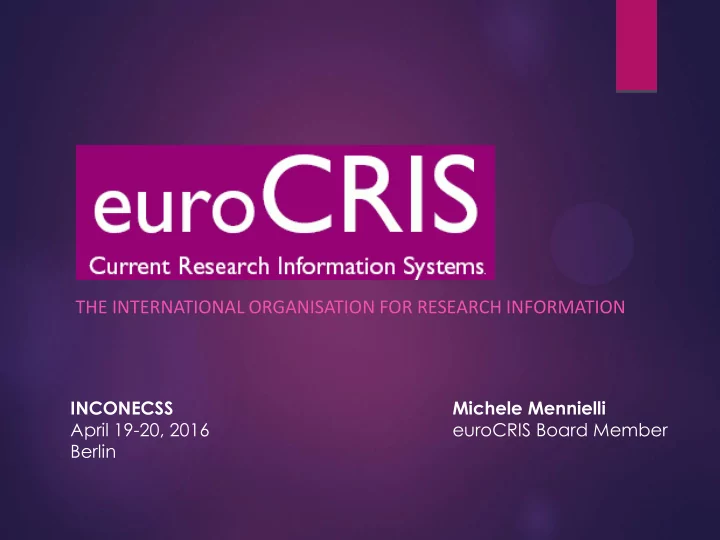

THE INTERNATIONAL ORGANISATION FOR RESEARCH INFORMATION INCONECSS Michele Mennielli April 19-20, 2016 euroCRIS Board Member Berlin
Index euroCRIS in a nutshell CERIF: the Common European Research Information Format The CRIS/IR Survey The future of Research Information: Research Data Management and Archiving Management of Multi-dimensional Researcher Portfolio Research Information Infrastructures
euroCRIS in a Nutshell
What is euroCRIS? An international not-for-profit association of experts and users of research information and research information systems (CRIS) Task Mission CERIF Events Groups To advance Development 1) CERIF Strategic Interoperability and governance Membership 2) Architecture in the Research of the CERIF Meetings & Development Community data model and (twice a year) 3) Best Practice through CERIF promotion of its & DRIS & C ommon use 4) CRIS-IR E uropean Conferences 5) Indicators R esearch (every 2 years) I nformation F ormat
CRIS2016 Conference June 8-11, 2016 – St. Andrews (Scotland, UK) More info here
The euroCRIS Network 13 45 >200 Strategic Countries Members Partners
CERIF C ommon E uropean R esearch I nformation F ormat
CERIF: Common European Research Information Format An international standard relational data model for storage and interoperability of research information Official EU Recommendation to Member States Standard exchange format (CERIF-XML) for interoperability between systems Reference model for the development of Research Information Systems (CRIS)
Strong points of CERIF CERIF is a comprehensive “legobox” of research information metadata Fine-grained structure & Broad Coverage flexible architecture • Projects • Input/Output of any (meta)data format • Persons • Expression (= translation) of • Organisations any formalised use case • Funding • Ingestion of an unlimited • Publications number of controlled • Datasets vocabularies (semantic layer) • Patents • Products • Bibliometrics • Impact Indicators • Equipment • …
Key feature of CERIF: Linking Entities Express the type and meaning of a relation between PERSON_PROJECT PERSON PROJECT Person_Id two objects Project_Id Role: Researcher - Same person, different roles for different projects Start: 01-01-2010 End: 31-12-2011 - Linking entities have a start- and end-date PERSON_PROJECT - Endless number of linking entities (roles, Person_Id typologies...) can exist between objects Project_Id Role: Manager Start: 01-03-2011 End: 31-12-2013 Classify objects according to a given classification CLASSIF_SCHEME PUBL_CLASS PUBLICATION scheme (controlled vocabulary, thesaurus) (e.g. Subject Areas) Publ_Id Class_term_Id Class_Scheme_Id A publication may be relevant for various disciplines Start: or subject areas End: B A CLASSIF-SCHEME CLASSIF_SCHEME Map various classification schemes to CLASS_CLASS E.g. Biochemstry E.g. Biochemstry each other, Class_term Id A keywords as used by keywords as used by Class_term Id B Medical disciplines Biologists Relation map the Biochemistry keyword list used by the (e.g. Is equal to, is subtype of, etc...) Medical discipline to the one used by Biologists
CERIF and the World of Research Widely recognized as a standard storage model for research information metadata and a standard for interoperability of research information (CERIF-XML) STOA-Report: Measuring Scientific Performance for Improved Policy Making , p. 14.
The CRIS/IR Survey
The CRIS/IR Task Group The CRIS-IR Task Group aims at furthering the science and technology of the linkage between CRIS and repositories and specifically open access institutional repositories of publications Joint euroCRIS-EUNIS Survey on CRIS and IR systems across Europe. The final report is available here: CRIS-IR http://www.eurocris.org/sites/default/files/files/cris- Task Group report-ED%281%29.pdf Interoperability between National CRISs and National Repository Network: a CRIS/IR interoperability workline for implementing Open Access (OA) in countries where there's little or no repository infrastructure
The CRIS-IR Survey 20 Countries 84 Institutions It is interesting to observe that 62% of institutions have both a CRIS and an IR. In the 18% of the cases where both CRIS and IR systems are available a single software platform is used for both
CRIS/IR Survey: Type of Content Are the two systems overlapping in their functionalities? The two systems are clearly complementary while IRs are the preferred ones for managing publications, dissertations and datasets, CRISs are regularly chosen for managing all the remaining data.
CRIS/IR Survey: Link to Internal Systems Almost 65% of the institutions have linked their CRIS and their IR CRISs are the preferred systems to link to legacy systems There is still very little integration with Learning Management Systems
The future of Research Information Research Data Management and Archiving
Research Data: role of CRIS selection Article analysis Dataset CRIS CRIS CRIS Linking publications to dataset + archiving of Data life cycle Registration of data. management (metadata) for dataset data collection publication
The future of Research Information Management of Multi-dimensional Researcher Portfolio
Towards multi-dimensional research(er) evaluation and monitoring tools The issue • Growing questioning of the “traditional” bibliometrics A possible solution • Combination of an extensive set of quantitative and qualitative indicators, altmetrics, narratives to give a complete picture of a researcher’s expertise, skills, experience, performance and impact The challenge for a CRIS • Integrate all these aspects and various types of data into their systems e.g.: http://research-acumen.eu/
Towards a DRE/VRE? The Digital Research(er) Environment is an extensive toolbox covering all information and management aspects of the research life cycle including research production tools
The future of Research Information Research Information Infrastructures
Research Information Infrastructure integration | networked structure | interoperability standards Identifiers | vocabularies | exchange format
Thank you very much for your attention! INCONECSS Michele Mennielli April 19-20, 2016 m.mennielli@cineca.it Berlin
Recommend
More recommend